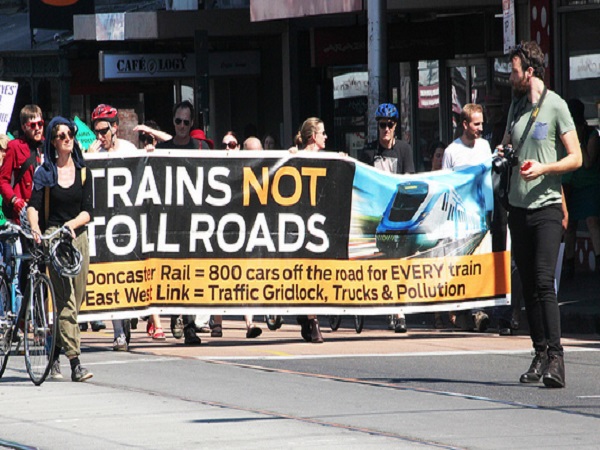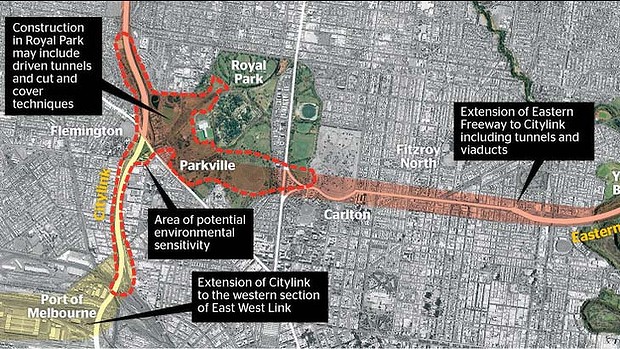The whole point of the East-West Link is the alleged positive transformation it will have on Melbourne. However, the logistics of building a freeway in the middle of a city of 4 million are so great, it is impossible to not step on a few hundred toes.
____________________________
Read ‘Explainer: The East-West Link part one’.
Read ‘Explainer: The East-West Link part two’.
____________________________
One big toe is Royal Park. A very large area of the park is expected to be closed off to the public and dug up for years, if construction on Stage One of the East-West Link is to go ahead. It is understood that a series of tunnels and viaducts would run through and out of the park in order to connect to CityLink, however, because the business case remains secret, no one knows for sure the extent of the impact.
Construction of Stage 1 – courtesy of the Age.
Residentially, The EWL would also mean the acquisition and demolition of 92 houses and 20 commercial properties. While landowners have been told they would be duly compensated, there is residential properties that would be affected by the finished freeway but are not on the list of acquisition.
Fifty-three apartments in Kensington are expected to see a decrease in their property value if the EWL is completed. An elevated road would pass within five metres of their windows, and pylons would be eight metres from their doors. But, Linking Melbourne (the authority behind the EWL planning) has denied these homeowners any compensation.
Construction woes set aside, the result of an operating EWL is argued to only increase congestion on other roads.
Ms Kanis, the Member for Melbourne, has claimed that traffic is expected to increase by 17 to 25 per cent on main streets in her electorate, including Mount Alexander Rd and Flemington Rd. Ms Kanis’ office tells upstart the Member was using data from pages 62 to 64 of the ‘Linking Melbourne Authority East-West Link — Eastern Traffic Impact Assessment‘.
The Member also stated that travel times promised by the Premier “defy reality”, saying that a road linking one congested freeway with another would only lead to congestion on the road itself.
Mayor Fristacky from Yarra City Council tells upstart that she expects residential streets to see an increase in traffic as people “rat run” through Yarra side streets in a bid to avoid the tollway.
This sentiment is echoed by Moreland City Council, who point out that Lygon St and Melville Rd traffic increased 38 and 30 per cent respectively during the first year of CityLink operation.
The councils’ concerns are exacerbated by the fact that the Major Transport Projects Facilitation Amendment Act 2013, has given the state government the legal authority to bypass councils and construct certain transport infrastructure, like the EWL, without permits or consultation.
While the idea is to increase project efficiency, it means councils could be left in the dark on construction areas and dates. The Act means councils might have to cater for traffic redirection and loss of local infrastructure without any warning or assistance from the state government.
So, is the East-West Link a crucial investment in the state’s future? Or is it nothing more than a giant money pit that will benefit next to no one? The arguments surrounding the Link are just as hard to grasp as its efficacy, but it is a project that would see Victorians paying it off for years, perhaps even decades, in one way or another.
The ramifications of such a project would change the face of the state forever, though, whether that is for better or worse, is for you to decide.
_________________________
Read part one here.
Read part two here.
_________________________
Campbell Elmer is a third-year Bachelor of Journalism student and deputy-editor of upstart. You can follow him on Twitter: @CampbellElmer.









